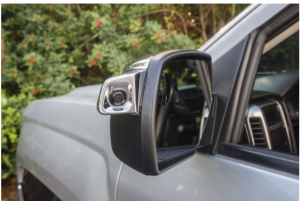Camera-based blind-spot monitoring systems help to prevent accidents by using simple and reliable technologies. These video-based safety systems can, in many cases, be integrated with a factory-installed infotainment system display to let you know if someone is driving in an adjacent lane so you can avoid changing lanes when someone is beside and prevent the need for sudden braking and swerving. At highway speeds, abrupt maneuvers can still result in an accident, even if there is no initial collision with the adjacent vehicle.
What is Your Blind Spot?
The Merriam-Webster dictionary defines a blind spot as “a portion of a field that cannot be seen or inspected with available equipment.” When you are driving and facing forward, the blind spot is the area on either side of your vehicle that is not visible in your peripheral vision, or your side- or rearview mirrors. If your sideview mirrors aren’t adjusted properly, an entire vehicle can be hidden from view unless you turn your head and perform a shoulder check before changing lanes.


The field of vision provided by a blind spot camera system clearly shows the presence of a vehicle, allowing you to adjust your driving intentions to prevent an accident.
How Does a Camera-Based Blind Spot Warning System Work?
In most implementations, a camera-based warning system uses a compact video camera mounted on the side or bottom of the sideview mirrors of your vehicle. These cameras are aimed rearward and toward the adjacent lanes to capture the presence of other vehicles.

Under normal driving, the camera system is inactive. Once you activate the turn signal, the image from the camera will be displayed on the color screen in your dash or a screen integrated into an aftermarket rearview mirror.
A glance at the camera image will let you know if there is someone beside you so you can determine whether it’s safe to change lanes. The video image remains on the screen until you turn off the turn signal.
Adding Blind Spot Monitoring to Your Vehicle
If your vehicle didn’t come with a blind spot monitoring system, use our dealer finder to track down a local specialist retailer that can install a system for you. They will start with a short interview to ensure they have a firm grasp of your expectations for the system. The next step is likely to be a vehicle inspection to determine the most-reliable, cost-effective way to add the required components. Once you have agreed to a solution, their technicians will take care of integrating the cameras and video control components into your vehicle.
As always, remember that the quality of components and workmanship is of the utmost importance when choosing an automotive safety solution.


